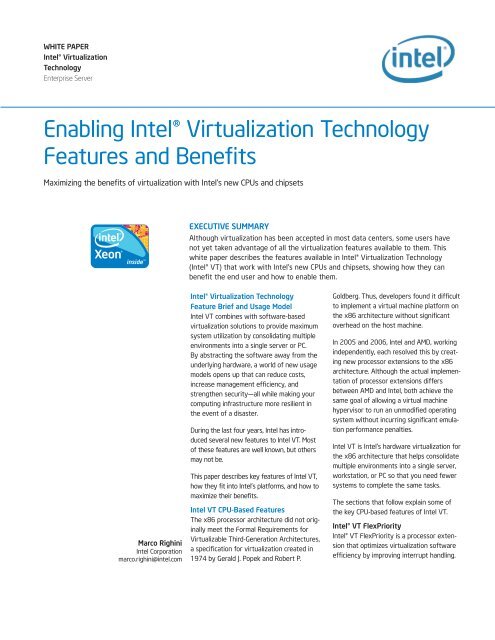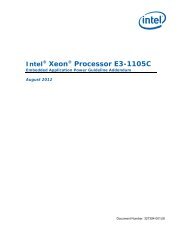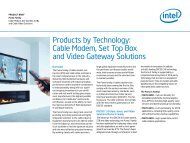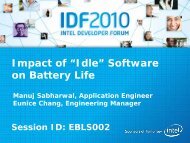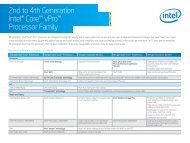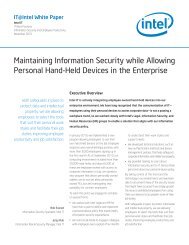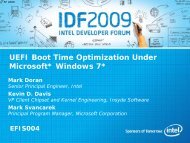Enabling Intel® Virtualization Technology Features and ...
Enabling Intel® Virtualization Technology Features and ...
Enabling Intel® Virtualization Technology Features and ...
Create successful ePaper yourself
Turn your PDF publications into a flip-book with our unique Google optimized e-Paper software.
WHITE PAPER<br />
Intel® <strong>Virtualization</strong><br />
<strong>Technology</strong><br />
Enterprise Server<br />
<strong>Enabling</strong> Intel® <strong>Virtualization</strong> <strong>Technology</strong><br />
<strong>Features</strong> <strong>and</strong> Benefits<br />
Maximizing the benefits of virtualization with Intel’s new CPUs <strong>and</strong> chipsets<br />
EXECUTIVE SUMMARY<br />
Although virtualization has been accepted in most data centers, some users have<br />
not yet taken advantage of all the virtualization features available to them. This<br />
white paper describes the features available in Intel® <strong>Virtualization</strong> <strong>Technology</strong><br />
(Intel® VT) that work with Intel’s new CPUs <strong>and</strong> chipsets, showing how they can<br />
benefit the end user <strong>and</strong> how to enable them.<br />
Marco Righini<br />
Intel Corporation<br />
marco.righini@intel.com<br />
Intel® <strong>Virtualization</strong> <strong>Technology</strong><br />
Feature Brief <strong>and</strong> Usage Model<br />
Intel VT combines with software-based<br />
virtualization solutions to provide maximum<br />
system utilization by consolidating multiple<br />
environments into a single server or PC.<br />
By abstracting the software away from the<br />
underlying hardware, a world of new usage<br />
models opens up that can reduce costs,<br />
increase management efficiency, <strong>and</strong><br />
strengthen security—all while making your<br />
computing infrastructure more resilient in<br />
the event of a disaster.<br />
During the last four years, Intel has introduced<br />
several new features to Intel VT. Most<br />
of these features are well known, but others<br />
may not be.<br />
This paper describes key features of Intel VT,<br />
how they fit into Intel’s platforms, <strong>and</strong> how to<br />
maximize their benefits.<br />
Intel VT CPU-Based <strong>Features</strong><br />
The x86 processor architecture did not originally<br />
meet the Formal Requirements for<br />
Virtualizable Third-Generation Architectures,<br />
a specification for virtualization created in<br />
1974 by Gerald J. Popek <strong>and</strong> Robert P.<br />
Goldberg. Thus, developers found it difficult<br />
to implement a virtual machine platform on<br />
the x86 architecture without significant<br />
overhead on the host machine.<br />
In 2005 <strong>and</strong> 2006, Intel <strong>and</strong> AMD, working<br />
independently, each resolved this by creating<br />
new processor extensions to the x86<br />
architecture. Although the actual implementation<br />
of processor extensions differs<br />
between AMD <strong>and</strong> Intel, both achieve the<br />
same goal of allowing a virtual machine<br />
hypervisor to run an unmodified operating<br />
system without incurring significant emulation<br />
performance penalties.<br />
Intel VT is Intel’s hardware virtualization for<br />
the x86 architecture that helps consolidate<br />
multiple environments into a single server,<br />
workstation, or PC so that you need fewer<br />
systems to complete the same tasks.<br />
The sections that follow explain some of<br />
the key CPU-based features of Intel VT.<br />
Intel® VT FlexPriority<br />
Intel® VT FlexPriority is a processor extension<br />
that optimizes virtualization software<br />
efficiency by improving interrupt h<strong>and</strong>ling.
<strong>Enabling</strong> Intel® <strong>Virtualization</strong> <strong>Technology</strong> <strong>Features</strong> <strong>and</strong> Benefits<br />
To enable Intel VT FlexPriority, you enable<br />
Intel VT extensions. Like most hardware<br />
features, Intel VT FlexPriority must be<br />
enabled by the hypervisor or virtual<br />
machine monitor (VMM), which allows multiple<br />
operating systems to run concurrently<br />
on a host computer.<br />
Intel VT FlexPriority eliminates most VM<br />
exits due to guest task priority registers<br />
(TPR) access. This reduces the virtualization<br />
overhead <strong>and</strong> improves I/O throughput.<br />
Table 1 lists which Intel CPUs have<br />
Intel VT FlexPriority; Table 2 maps Intel<br />
VT features to CPUs. Figure 1 shows the<br />
reduction of EXITs <strong>and</strong> also looks at the<br />
I/O throughput measured (best-case<br />
scenario).<br />
Intel® VT FlexMigration<br />
Intel® VT FlexMigration is a feature of Intel<br />
<strong>Virtualization</strong> <strong>Technology</strong> that enables you<br />
to build one compatible virtualization pool <strong>and</strong><br />
conduct live virtual machine (VM) migration<br />
across all Intel® Core microarchitecture-based<br />
servers. It gives you the power to choose the<br />
right server platform to best optimize performance,<br />
cost, power, <strong>and</strong> reliability.<br />
Combined with support from a virtualization<br />
software provider, this feature allows IT to<br />
maximize flexibility by providing the ability<br />
to build a single live migration compatibility<br />
pool with multiple generations of Intel Xeon<br />
processor-based servers.<br />
For details on Intel VT FlexMigration, visit<br />
http://communities.intel.com/docs/DOC-4124.<br />
Virtual Processor IDs (VPID)<br />
Traditionally, every time a hypervisor<br />
switched execution between different VMs,<br />
the VM <strong>and</strong> its data structure had to be<br />
flushed out of the transition look-aside<br />
buffers (TLB) associated with the CPU<br />
caches, since the hypervisor had no information<br />
on which cache line was associated with<br />
any particular VM.<br />
With virtual processor IDs (VPID), a VM ID<br />
tag in the CPU hardware structures (e.g.,<br />
TLB) associates cache lines with each VM<br />
actively running on the CPU. This permits<br />
the CPU to flush only the cache lines<br />
associated with a particular VM when it<br />
is flushed from the CPU, avoiding the<br />
need to reload cache lines for a VM that<br />
was not migrated <strong>and</strong> resulting in lower<br />
overhead.<br />
Table 1. Intel Processors with Intel® VT FlexPriority<br />
Intel® Enhanced vMotion* Example<br />
Microarchitecture Compatibility (EVC) Setting<br />
45nm Intel® Core Intel® Xeon® processor (45nm) Intel Xeon processor<br />
processor family Intel Core 2 processor 5400 or 7400 series<br />
Next-generation Intel® Intel Xeon processor Intel Xeon processor<br />
microarchitecture Intel Core i7 processor (45nm) 5500 or 7500 series<br />
Intel Xeon processor Intel Xeon processor Intel Xeon processor<br />
5600 series Intel Core i7 processor (32nm ) 5600 series<br />
Table 2. Intel <strong>Virtualization</strong> <strong>Technology</strong> Feature <strong>and</strong> CPU Mapping<br />
Intel® Xeon® Processor<br />
7400 7500/ 5500 5600 3300/ 3400<br />
Series 6500 Series Series 3100 Series<br />
Series<br />
Series<br />
VT-x Base ̌ ̌ ̌ ̌ ̌ ̌<br />
Intel® VT FlexPriority ̌ ̌ ̌ ̌ ̌ ̌<br />
Intel® VT FlexMigration ̌ ̌ ̌ ̌ ̌ ̌<br />
Extended Page ̌ ̌ ̌ ̌<br />
Tables (EPT)<br />
Virtual Processor ̌ ̌ ̌ ̌<br />
ID (VPID)<br />
Guest Preemption ̌ ̌ ̌ ̌<br />
Timer<br />
Descriptor-Table ̌ ̌ ̌ ̌<br />
Exiting<br />
Pause-Loop Exiting<br />
TXT<br />
Real Mode Support<br />
̌<br />
VPID is available on all new Intel Xeon processors<br />
starting with the 5500, 5600, <strong>and</strong> 7500 series.<br />
VGuest Preemption Timer<br />
The Guest Preemption Timer is a mechanism<br />
that enables a VMM to preempt the<br />
execution of a guest OS.<br />
Programmable by VMM, the timer causes<br />
the VM to exit when the timer expires. It<br />
has no impact on interrupt architecture.<br />
̌<br />
̌<br />
2
<strong>Enabling</strong> Intel® <strong>Virtualization</strong> <strong>Technology</strong> <strong>Features</strong> <strong>and</strong> Benefits<br />
This feature helps VMM vendors fulfill flexibility<br />
<strong>and</strong> quality of service guarantees. It<br />
can help when you need to switch tasks or<br />
allocate a certain amount of CPU power to a<br />
task. For telecom <strong>and</strong> networking applications,<br />
it makes virtualization a useful tool—<br />
<strong>and</strong> possibly a must-have feature.<br />
Descriptor Table Exiting<br />
This feature allows a VMM to protect a<br />
guest OS from internal attack by preventing<br />
relocation of key system data structures.<br />
Pause-Loop Exiting<br />
This feature is a hardware assist to enable<br />
detection of spin locks in guest software<br />
<strong>and</strong> avoid lock-holder preemption. It helps to<br />
reduce overhead <strong>and</strong> improve performance.<br />
Real Mode Support<br />
This feature allows guests to operate in<br />
real mode, removing the performance<br />
overhead <strong>and</strong> complexity of an emulator.<br />
Uses include:<br />
• Early VMM load<br />
• Guest boot <strong>and</strong> resume<br />
Extended Page Table (EPT)<br />
Typical Intel® architecture 32-page tables<br />
(referenced by control register CR3) translate<br />
from linear addresses to guest-physical<br />
addresses. With the Extended Page Table<br />
(EPT) feature, a separate set of page tables<br />
(EPTs) translate from guest-physical<br />
addresses to host-physical addresses that<br />
are used to access memory. As a result, the<br />
guest OS can be allowed to modify its own<br />
page tables <strong>and</strong> directly h<strong>and</strong>le page faults.<br />
This allows a VMM to avoid the VM exits<br />
associated with page-table virtualization,<br />
which is a major source of virtualization<br />
overhead without EPT.<br />
Figure 2 shows how the EPT works.<br />
Intel® Trusted Execution <strong>Technology</strong><br />
Intel® Trusted Execution <strong>Technology</strong> (Intel®<br />
TXT) provides a hardware-based security<br />
foundation on which to build <strong>and</strong> maintain<br />
a chain of trust to protect the platform<br />
from software-based attacks.<br />
The goal of Intel TXT is to provide an accurate<br />
measurement, at launch, of the measured<br />
launch environment (MLE) through the<br />
hardware features built into the CPU <strong>and</strong><br />
chipset. This hardware-based security provides<br />
a foundation on which trusted platform<br />
solutions can be built to protect the<br />
platform from software-based attacks.<br />
Figure 3 shows how Intel TXT works.<br />
<strong>Features</strong> of Intel TXT include:<br />
• Verified Launch. An Intel TXT<br />
hardware-based chain of trust<br />
enables launch of MLE into a known,<br />
expected state. Changes to MLE<br />
can be detected via hash-based<br />
measurements.<br />
• Protected Configuration. Intel TXT<br />
hardware protects the launched configurations<br />
from malicious software,<br />
maintaining the integrity of the<br />
measured launched environment’s<br />
identity.<br />
• Secret Protection. Intel TXT<br />
hardware removes residual data<br />
at improper MLE shut-down, protecting<br />
data from memory snooping<br />
software.<br />
Without Intel® VT FlexPriority<br />
With Intel VT FlexPriority<br />
Figure 1. Reduction of<br />
EXITs with Intel® VT<br />
FlexPriority<br />
3
<strong>Enabling</strong> Intel® <strong>Virtualization</strong> <strong>Technology</strong> <strong>Features</strong> <strong>and</strong> Benefits<br />
Intel® VT for Directed I/O (Intel® VT-d)<br />
In computing, an input/output memory management<br />
unit (IOMMU) is a memory management<br />
unit (MMU) that connects a digital<br />
media adapter (DMA)-capable I/O bus to the<br />
main memory. Like a traditional MMU, which<br />
translates CPU-visible virtual addresses to<br />
physical addresses, the IOMMU takes care of<br />
mapping device-visible virtual addresses<br />
(also called device addresses or I/O addresses<br />
in this context) to physical addresses.<br />
Some units also provide memory protection<br />
from misbehaving devices.<br />
Intel® VT-d is a feature integrated into the<br />
chipset <strong>and</strong> therefore not related to the CPU.<br />
Before Intel VT-d <strong>and</strong> hypervisors supporting it,<br />
any VM running on top of a VMM was seeing<br />
emulated, or para-virtualized, devices. Figure 4<br />
shows how Intel VT-d works.<br />
No matter what type of hardware was physically<br />
present in the server, the VM itself sees a virtualized<br />
device. So, for example, on VMware<br />
vSphere*, you would typically see a VMXnet*<br />
network card instead of the real network interface<br />
card (NIC) installed on the server.<br />
This has both pros <strong>and</strong> cons:<br />
• Pros: This hides any type of change<br />
between the hardware vendors <strong>and</strong><br />
makes it possible for VMs to migrate<br />
easily.<br />
• Cons: Performance takes a hit. This is<br />
true even if the emulated device is<br />
based on a para-virtualized or synthetic<br />
driver, either in terms of CPU utilization,<br />
b<strong>and</strong>width, or latency.<br />
Figure 2 Extended Page Table<br />
Figure 3. Intel® Trusted<br />
Execution <strong>Technology</strong><br />
4
<strong>Enabling</strong> Intel® <strong>Virtualization</strong> <strong>Technology</strong> <strong>Features</strong> <strong>and</strong> Benefits<br />
When Intel VT-d is enabled, the guest OS can<br />
choose to use either the traditional approach<br />
or, as needed, pass-through devices.<br />
In pass-through mode, the PCI* device is not<br />
allocated by the hypervisor <strong>and</strong>, therefore,<br />
the device can be allocated directly by a VM<br />
which now sees the physical PCI device. (Of<br />
course, a portion of the memory of that<br />
device is also remapped to the VM through<br />
the DMA remap engine.) Intel VT-d needs to<br />
be enabled in the BIOS <strong>and</strong> is a separate flag.<br />
Interrupt-Remapping Support<br />
The Interrupt-Remapping feature enables the<br />
VMM to isolate interrupts to CPUs assigned<br />
to a given VM <strong>and</strong> to remap/reroute physical<br />
I/O device interrupts. When enabled, this feature<br />
helps ensure an efficient migration of<br />
the interrupts across CPUs.<br />
Queued-Invalidation Support<br />
Queued-Invalidation enables the VMM to<br />
batch digital media translation invalidations.<br />
This gives the end user better performance.<br />
Address Translation Services (ATS) support<br />
Address Translation Services (ATS) is a PCI-<br />
SIG specification that allows PCI-e devices to<br />
cache the IOTLB entries (used for DMA<br />
remapping) of that device directly in the<br />
device itself. This helps the performance of<br />
high-end devices, since the translations can<br />
be cached at the device level <strong>and</strong> the device<br />
need not depend on the chipset IOTLB cache.<br />
This BIOS feature needs to be enabled to<br />
permit proper Intel VT-d implementation.<br />
Large Intel VT-d Pages<br />
The Large Intel VT-d Pages feature enables<br />
2MB <strong>and</strong> 1GB pages in Intel VT-d page<br />
tables. It enables the sharing of Intel VT-d<br />
<strong>and</strong> EPT page tables.<br />
Figure 4. How Intel VT-d works<br />
Table 3. Intel VT-d Feature <strong>and</strong> Chipset Mapping<br />
Intel VT-d Intel® Intel® Intel Intel Intel Intel<br />
Feature Itanium® Xeon® Xeon Xeon Xeon Xeon<br />
Proc. Proc. Proc. Proc. Proc. Proc.<br />
9000 7300 7500 5500/ 3200/ 3400<br />
Series Series Series 5200 3100 Series<br />
Series Series<br />
Intel VT-d Base ̌ ̌ ̌ ̌ ̌<br />
Interrupt ̌ ̌ ̌<br />
Remapping<br />
Support<br />
Queued ̌ ̌ ̌ ̌<br />
Invalidation<br />
Support<br />
Address Translation ̌ ̌<br />
Services Support<br />
Large Intel ̌ ̌<br />
VT-d Addresses<br />
Support for<br />
PCI-SIG I/O<br />
<strong>Virtualization</strong><br />
St<strong>and</strong>ards<br />
Support for PCI- ̌ ̌ ̌ ̌<br />
SIG I/O<br />
<strong>Virtualization</strong><br />
St<strong>and</strong>ards<br />
5
<strong>Enabling</strong> Intel® <strong>Virtualization</strong> <strong>Technology</strong> <strong>Features</strong> <strong>and</strong> Benefits<br />
I/O Hardware Assist <strong>Features</strong> of Intel®<br />
<strong>Virtualization</strong> <strong>Technology</strong> for<br />
Connectivity (Intel® VT-C)<br />
Virtual Machine Device Queue<br />
The Virtual Machine Device Queue (VMDQ)<br />
feature is a hardware assist in the Intel networking<br />
silicon that improves data processing<br />
performance by improving throughput <strong>and</strong><br />
lowering CPU utilization. This is a more effective<br />
way of sorting <strong>and</strong> grouping data packets<br />
at the NIC instead of the VMM.<br />
Intel VMDQ on Intel® Ethernet controllers can<br />
lower CPU utilization <strong>and</strong> improve LAN<br />
throughput by supporting:<br />
• Reduced decisions/data copies by VMM<br />
switch<br />
• VM transmit fairness with round-robin<br />
servicing<br />
• Operation that is independent from<br />
Intel VT-d<br />
On the new Intel® 82576 <strong>and</strong> 82599 10-<br />
Gigabit Ethernet controllers, Intel VMDQ provides:<br />
• Flexible b<strong>and</strong>width allocation per VM<br />
(only on Intel 82599 Ethernet<br />
Controller)<br />
• Hardware support for VM-to-VM<br />
loop-back<br />
Table 4. OEMs with Intel SR-IOV Cards<br />
Cisco Dell Fujitsu HP IBM Sun<br />
10 GbE NIC ̌ ̌ ̌ ̌<br />
10 GbE Mezz ̌ ̌ ̌ ̌ ̌<br />
Quad-Port GbE ̌ ̌ ̌ ̌ ̌ ̌<br />
Note: HP decided to implement its proprietary technology, called Flex-10*, to make this possible.<br />
Intel VMDQ works with VMMs to remove<br />
some virtual network overhead when moving<br />
traffic from the network adapter to the<br />
VM. Nothing needs to be enabled on the<br />
card itself.<br />
Single-Root I/O <strong>Virtualization</strong> (SR-IOV)<br />
The Single-Root I/O <strong>Virtualization</strong> (SR-IOV)<br />
feature is a PCI Special Interest Group (PCI-<br />
SIG) specification. Intel, along with other<br />
industry leaders, is actively participating in<br />
the PCI-SIG working group to define new<br />
st<strong>and</strong>ards for enhancing virtualization capabilities<br />
of I/O devices. SR-IOV provides a<br />
st<strong>and</strong>ard mechanism for devices to advertise<br />
their ability to be simultaneously shared<br />
among multiple virtual machines. It also<br />
allows for the partitioning of a PCI function<br />
into many virtual interfaces for the purpose<br />
of sharing the resources of a PCI Express*<br />
(PCIe*) device in a virtual environment. Intel<br />
plans to support the SR-IOV specification in<br />
its networking devices.<br />
Each virtual function can support a unique<br />
<strong>and</strong> separate data path for I/O-related functions<br />
within the PCIe hierarchy. Use of SR-<br />
IOV with a networking device, for example,<br />
allows the b<strong>and</strong>width of a single port (function)<br />
to be partitioned into smaller slices that<br />
may be allocated to specific virtual machines,<br />
or guests, via a st<strong>and</strong>ard interface. A common<br />
methodology for configuration <strong>and</strong> management<br />
is also established to further<br />
enhance the interoperability of various<br />
devices in a PCIe hierarchy. This resource<br />
sharing can increase the total utilization of<br />
any given resource presented on an SR-IOVcapable<br />
PCIe device, potentially reducing the<br />
cost of a virtual system.<br />
Intel-enabled NICs are:<br />
• Intel® 82576 Gigabit Ethernet Controller<br />
• Intel® 82599 10-Gigabit Ethernet<br />
Controller<br />
PCI-SIG SR-IOV ecosystem requirements<br />
include:<br />
• Broadcast/multicast replication in<br />
hardware<br />
• A SR-IOV-capable NIC<br />
• Intel VT-d<br />
6
<strong>Enabling</strong> Intel® <strong>Virtualization</strong> <strong>Technology</strong> <strong>Features</strong> <strong>and</strong> Benefits<br />
• BIOS support<br />
• VM ability to support this feature<br />
Table 4 lists OEMs with Intel SR-IOV cards.<br />
Intel VT ISV Support<br />
Tables 5 through 7 show ISVs that support<br />
the features of Intel VT.<br />
Summary<br />
All the features in Intel <strong>Virtualization</strong><br />
<strong>Technology</strong> help exp<strong>and</strong> its usefulness by<br />
enabling either new virtualized environment<br />
usage models or better performance.<br />
When you enable Intel VT <strong>and</strong> Intel VT-d,<br />
you enable all of its major features. (The<br />
sub-features of Intel VT-d need to be<br />
enabled separately if the target VMM supports<br />
it. You can enable pass-through, with<br />
or without SR-IOV needs, after Intel VT-d<br />
enablement within the software stack.<br />
VMDq is enabled by default if the NIC supports<br />
it.)<br />
By learning to enable <strong>and</strong> use all the features<br />
of Intel <strong>Virtualization</strong> <strong>Technology</strong>, you<br />
can reduce costs, increase management<br />
efficiency, <strong>and</strong> strengthen security—all<br />
while making your computing infrastructure<br />
more resilient in the event of a disaster.<br />
To learn more about Intel <strong>Virtualization</strong><br />
<strong>Technology</strong>, visit www.intel.com/technology/virtualization.<br />
Table 5. ISV Support for Intel VT<br />
Intel VT-d VMware Micro- Xen KVM Citrix Red SuSE Oracle Parallels<br />
Feature soft Hat<br />
Intel VT-d Base ̌ ̌ ̌ ̌ ̌ ̌ ̌ ̌ ̌<br />
Intel VT FlexPriority ̌ ̌ ̌ ̌ ̌ ̌ ̌ ̌ ̌<br />
Intel VT FlexMigration ̌ ̌ ̌ ̌ TBD TBD TBD TBD TBD<br />
Extended Page Tables (EPT) ̌ ̌ ̌ ̌ ̌ ̌ ̌ ̌ ̌<br />
Virtual Process ID( VPID) ̌ ̌ ̌ ̌ ̌ TBD ̌ TBD ̌<br />
Guest Preemption Timer TBD TBD TBD TBD TBD TBD TBD TBD TBD<br />
Descriptor Table Exiting TBD TBD ̌ TBD TBD TBD TBD TBD TBD<br />
Pause-Loop Exiting TBD ̌ ̌ WIP TBD TBD TBD TBD TBD<br />
Real Mode Support TBD TBD ̌ ̌ TBD TBD TBD TBD TBD<br />
7
<strong>Enabling</strong> Intel® <strong>Virtualization</strong> <strong>Technology</strong> <strong>Features</strong> <strong>and</strong> Benefits<br />
Table 6. ISV Intel VT-d Support Matrix<br />
Intel VT-d VMware Micro- Xen KVM Citrix Red SuSE Oracle Parallels<br />
Feature soft Hat<br />
VT-d Base ̌ TBD ̌ ̌ TBD ̌ ̌ TBD ̌<br />
Interrupt-Remapping Support ̌ TBD ̌ ̌ TBD TBD TBD TBD TBD<br />
Queued-Invalidation Supporet ̌ TBD ̌ ̌ TBD TBD TBD TBD TBD<br />
Address Translation Services TBD TBD ̌ ̌ TBD TBD TBD TBD TBD<br />
Large VT-d Pages TBD TBD TBD TBD TBD TBD TBD TBD TBD<br />
Table 7. ISV VMDq <strong>and</strong> Intel NIC Support Matrix<br />
I/O Silicon Oplin Niantic Zoar Kawela<br />
Base VMDq Base VMDq Base VMDq Base<br />
Driver Driver Driver Driver VMDq<br />
ESX 3.5 Now Now Now Now Now TBD Now TBD<br />
ESXi 3.5 Now Now Now Now Now N/A N/A N/A<br />
ESX 4.0 Now Now Now Now Now TBD Now TBD<br />
Xen* Kernel Now TBD Now TBD Now TBD Now TBD<br />
Microsoft* Hyper-V Now N/A Now N/A Now N/A Now N/A<br />
Microsoft* Hyper-V R2 Now Now Now Now Now Now Now Now<br />
8
INFORMATION IN THIS DOCUMENT IS PROVIDED IN CONNECTION WITH INTEL® PRODUCTS. NO LICENSE, EXPRESS OR IMPLIED, BY ESTOPPEL OR OTHERWISE,<br />
TO ANY INTELLECTUAL PROPERTY RIGHTS IS GRANTED BY THIS DOCUMENT. EXCEPT AS PROVIDED IN INTEL’S TERMS AND CONDITIONS OF SALE FOR SUCH<br />
PRODUCTS, INTEL ASSUMES NO LIABILITY WHATSOEVER, AND INTEL DISCLAIMS ANY EXPRESS OR IMPLIED WARRANTY, RELATING TO SALE AND/OR USE OF<br />
INTEL PRODUCTS INCLUDING LIABILITY OR WARRANTIES RELATING TO FITNESS FOR A PARTICULAR PURPOSE, MERCHANTABILITY, OR INFRINGEMENT OF<br />
ANY PATENT, COPYRIGHT OR OTHER INTELLECTUAL PROPERTY RIGHT. UNLESS OTHERWISE AGREED IN WRITING BY INTEL, THE INTEL PRODUCTS ARE NOT<br />
DESIGNED NOR INTENDED FOR ANY APPLICATION IN WHICH THE FAILURE OF THE INTEL PRODUCT COULD CREATE A SITUATION WHERE PERSONAL INJURY<br />
OR DEATH MAY OCCUR.<br />
Performance tests <strong>and</strong> ratings are measured using specific computer systems <strong>and</strong>/or components <strong>and</strong> reflect the approximate performance of Intel products as<br />
measured by those tests. Any difference in system hardware or software design or configuration may affect actual performance. Buyers should consult other<br />
sources of information to evaluate the performance of systems or components they are considering purchasing. For more information on performance tests <strong>and</strong><br />
on the performance of Intel products, visit Intel Performance Benchmark Limitations.<br />
Intel may make changes to specifications <strong>and</strong> product descriptions at any time, without notice. Designers must not rely on the absence or characteristics of any<br />
features or instructions marked “reserved” or “undefined.” Intel reserves these for future definition <strong>and</strong> shall have no responsibility whatsoever for conflicts or<br />
incompatibilities arising from future changes to them. The information here is subject to change without notice. Do not finalize a design with this information.<br />
The products described in this document may contain design defects or errors known as errata which may cause the product to deviate from published specifications.<br />
Current characterized errata are available on request. Contact your local Intel sales office or your distributor to obtain the<br />
latest specifications <strong>and</strong> before placing your product order. Copies of documents which have an order number <strong>and</strong> are referenced<br />
in this document, or other Intel literature, may be obtained by calling 1-800-548-4725, or by visiting Intel’s Web site at<br />
www.intel.com.<br />
Copyright © 2010 Intel Corporation. All rights reserved. Intel, the Intel logo, <strong>and</strong> Xeon are trademarks of Intel Corporation in the<br />
U.S. <strong>and</strong> other countries.<br />
*Other names <strong>and</strong> br<strong>and</strong>s may be claimed as the property of others. Printed in USA SS/MR/0610 Please Recycle


